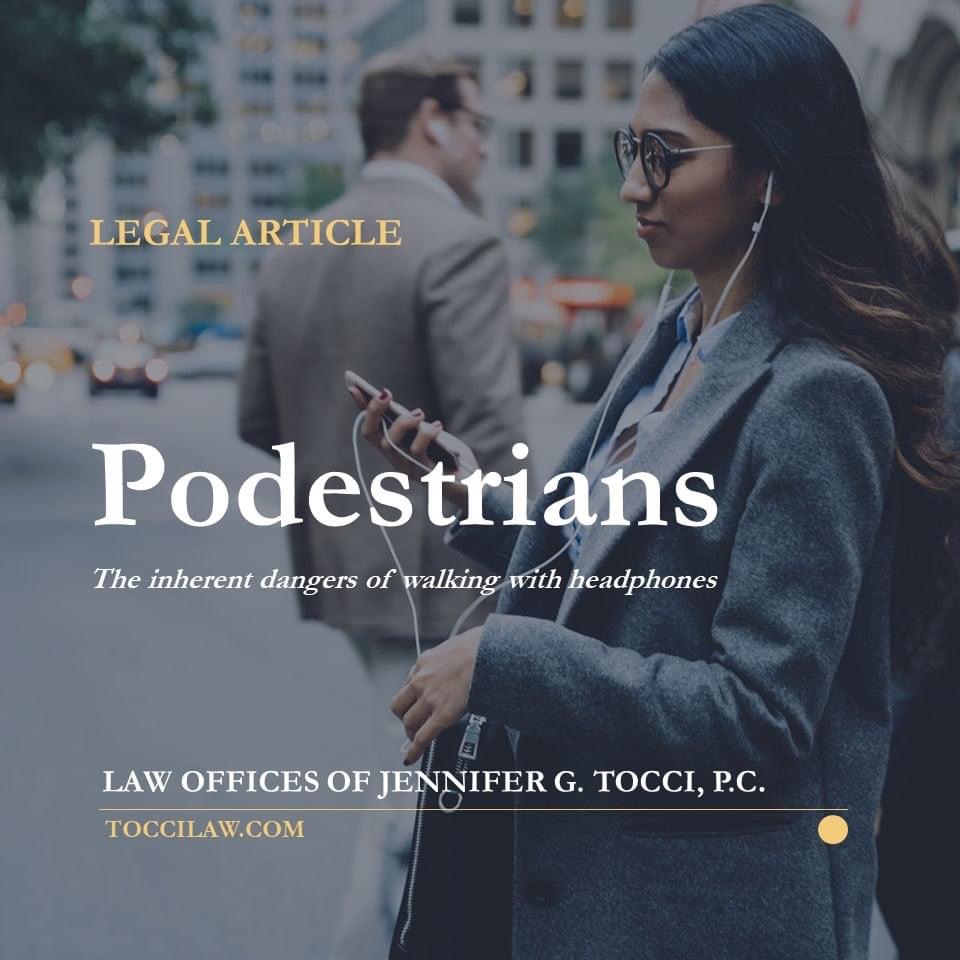Headphones, earphones, earbuds, AirPods, the tiny speakers for each of your ears transmitting the sound from your portable device, are part of daily life. We have been utilizing headphones to listen to music, videos, and for phone calls for decades. In light of the COVID-19 pandemic, we use our portable devices more frequently, attending class and virtual meetings, making headphones handier. Despite their convenience, they can be unsafe to use while walking, especially for children and college students. They impair judgement and coordination, diminish the ability to perceive and hear. Walking with earbuds in increases the likelihood of being struck by a motor vehicle while walking or standing.
The Stats:
In 2019 on Long Island, there were 1,347 pedestrian-motor vehicle accidents causing bodily injuries. 60 of those cases were fatal. [Sidebar: The breakdown- 29 fatalities in Nassau and 31 in Suffolk. 829 personal injuries in Nassau and 458 in Suffolk.] Headphones recorded in the police report as a contributing factor to pedestrian accidents is on the rise.
Reduction in Hearing:
While they help us tune in, earbuds also disconnect us from our surroundings. Being disconnected from your surroundings while walking is a recipe for disaster. Without distraction, it is risky to walk near traffic; muffling your ability to hear or directing your attention away from the road increases the risk. While you or your children may take precautions, maintaining distance from the street, walking on the sidewalk, looking both ways before crossing, without the ability to hear fully and accurately, avoiding an accident may be difficult. Sounds are often our first indication of danger. A device blocking the ear canal, even without volume, can soften the noises that may alert us of an accident. Sounds of tires rolling on pavement are soft, but they allow us to perceive where we are in relation to our surroundings, how fast a vehicle is approaching and the distance between us and the vehicle. Inhibiting our sense of sound reduces our ability of perceptual awareness. Further, the sounds of loud engines, whipping, swerving, screeching tires, and shouting voices can be undetectable when using an earbud. Utilizing the volume further diminishes the ability to hear the first signs of potential danger. Horns are designed to alert people to potential risk. Earbud volumes can reach a decibel high enough to drown out a honking horn. Regardless of the volume level, headphone noise cancellation quality has increased dramatically, preventing the capacity to hear nearby vehicles and horns. Combine this with the advancement of quieter vehicle engines, for example, electric and hybrid vehicles, and it can be dangerous, if not deadly.
Reduction in Focus:
Our bodies react to what we see and hear. Our capability of sensing and avoiding danger is fastest and sharpest when we can identify warnings and when we can identify them early. When wearing headphones, your focus is divided between your surroundings and to what you choose to listen. Wearing headphones can thereby impair your judgment and coordination. Even where you are passively listening, you intermittently focus in on the sound, thus focus off of the surroundings. This distraction can cheapen decision-making skills, triggering you to prematurely cross the street or not look where you are going. This phenomenon is called “inattentional blindness.” Inattentional blindness may prevent you from properly processing the information you see. For example, you may go through the motions of looking both ways, but your inattention thwarts your judgment and coordination, causing you to proceed unsafely or delay your reaction time.
Walking While Listening Safely:
The safest way to avoid limitations in your perception of danger while walking is to not use earbuds at all while doing so. Try not to allow your children to walk around near traffic with earbuds. This may be increasingly difficult to monitor during the COVID-19 pandemic. Your children may be home alone, presumably attending class, while you are at work, unable to monitor their every move. Discuss with your children the increased danger of walking near traffic with earbuds.
College students on busy campuses, such as Stony Brook University, should refrain from using earbuds while walking on campus (at least near traffic). If you refuse to remove from your ears, turn off the volume when walking near roadways.
With or without earbuds, do not assume drivers can see you walking, regardless of whether it is daylight outside or because you are wearing reflective gear. Drivers may presume you are paying attention to where you are walking and can sense their vehicle approaching. It is safe to assume that drivers cannot see that you have headphones in your ears. This is especially true if you are using AirPods.
If you or your child has been injured by a motor vehicle while walking or standing contact the Law Offices of Jennifer G. Tocci, P.C. to schedule a free thirty-minute consultation to discuss your rights and options (631) 343-7676.
Law Offices of Jennifer G. Tocci, P.C., 353 Veterans Memorial Highway, Suite 200, Commack, New York 11725.









